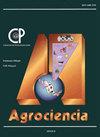柑橘砧木育苗基质中的松树皮比例
IF 0.5
4区 农林科学
Q4 AGRICULTURE, MULTIDISCIPLINARY
引用次数: 0
摘要
果树栽培要求砧木具有抗生物和非生物胁迫的能力。所使用的容器大小和基质是其生长发育的重要组成部分。尽管如此,有关基质对苗圃条件下柑橘类植物生长发育影响的研究却很少。本研究旨在评估在受保护的环境(温室)中,基质中三种不同比例的松树皮对三种正在生长的柑橘砧木的影响。研究在墨西哥韦拉克鲁斯州卡索内斯德埃雷拉的卡索内斯苗圃进行,假设树皮比例的增加会导致基质物理和化学特性的提高,并促进三种砧木的生长。该研究采用了完全随机的因子排列设计(A × B)。因子 A(砧木)有三个水平:Citrus aurantium L.(酸橙)、C. volkameriana Pasq.(Volkamer 柠檬)和 C. sinensis L. × Poncirus trifoliata L.(Citrage C-35)。因子 B(基质)有四个水平(0%、10%、20% 和 30%松树皮),共 12 个处理,每个处理重复 20 次。测定了基质的物理和化学特性,并测量了植株高度和茎秆直径。松树皮对表观密度和实际密度、总孔隙率、电导率和阳离子交换容量有积极影响。在嫁接后的第二和第三个月,三种砧木的生长活力都更强。在总孔隙率为 46-54 % 的基质中生长时,Volkamer 柠檬、Citrage C-35 和酸橙砧木的株高分别达到 124.1 厘米、110.5 厘米和 84.5 厘米;茎直径达到 6.9 毫米。在基质中添加松树皮后,孔隙度和阳离子交换容量都有所增加。通过评估基质并按比例进行管理,可以在移栽后四个月内获得适合嫁接的植株(茎干直径为 5 至 6 毫米)。这样一来,苗圃中花费的时间就会减少,成本也会降低。本文章由计算机程序翻译,如有差异,请以英文原文为准。
PINE BARK RATIO IN SUBSTRATE FOR CITRUS ROOTSTOCK NURSERY PRODUCTION
Fruit tree cultivation requires rootstocks that are resistant to both biotic and abiotic stresses. The container size and substrate used are essential components in their development. Despite this, there are few studies on the impact of substrates on plant development in citrus trees under nursery conditions. This study aimed to assess the effects of three different ratios of pine bark in the substrate of three developing citrus rootstocks in a protected environment (greenhouse). The study conducted at the Cazones Nursery in Cazones de Herrera, Veracruz, Mexico, hypothesized that an increase in bark proportion would lead to a rise in the physical and chemical characteristics of the substrate and the development of the three rootstocks. The study utilized a completely randomized design with a factorial arrangement (A × B). Factor A (rootstock) had three levels: Citrus aurantium L. (Sour Orange), C. volkameriana Pasq. (Volkamer Lemon), and C. sinensis L. × Poncirus trifoliata L. (Citrage C-35). Factor B (substrate) had four levels (0, 10, 20, and 30 % pine bark), resulting in 12 treatments with 20 repetitions each. The physical and chemical characteristics of the substrates were determined, and the plant height and stem diameter were measured. Pine bark positively affected the apparent and real densities, total porosity, electrical conductivity, and cation exchange capacity. The growth dynamics of the three rootstocks were greater during the second and third months after grafting. When grown in substrates with a total porosity of 46–54 %, Volkamer Lemon, Citrage C-35, and Sour Orange rootstocks reached a plant height of 124.1, 110.5, and 84.5 cm, respectively; the stem diameter reached 6.9 mm. Porosity and cation exchange capacity increased when pine bark was added to the substrates. By evaluating the substrates and managing them proportionally, it is possible to obtain plants suitable for grafting (with 5 to 6 mm of stem) within four months after transplanting. This results in less time spent in the nursery and reduced costs.
求助全文
通过发布文献求助,成功后即可免费获取论文全文。
去求助
来源期刊

Agrociencia
农林科学-农业综合
CiteScore
0.50
自引率
33.30%
发文量
51
审稿时长
18-36 weeks
期刊介绍:
AGROCIENCIA is a scientific journal created and sponsored by the Colegio de Postgraduados. Its main objective is the publication and diffusion of agricultural, animal and forestry sciences research results from mexican and foreign scientists. All contributions are peer reviewed. Starting in the year 2000, AGROCIENCIA became a bimonthly and fully bilingual journal (Spanish and English versions in the same issue). Since 2007 appears every month and a half (eight issues per year). In addition to the printed issues, the full content is available in electronic format.
 求助内容:
求助内容: 应助结果提醒方式:
应助结果提醒方式:


